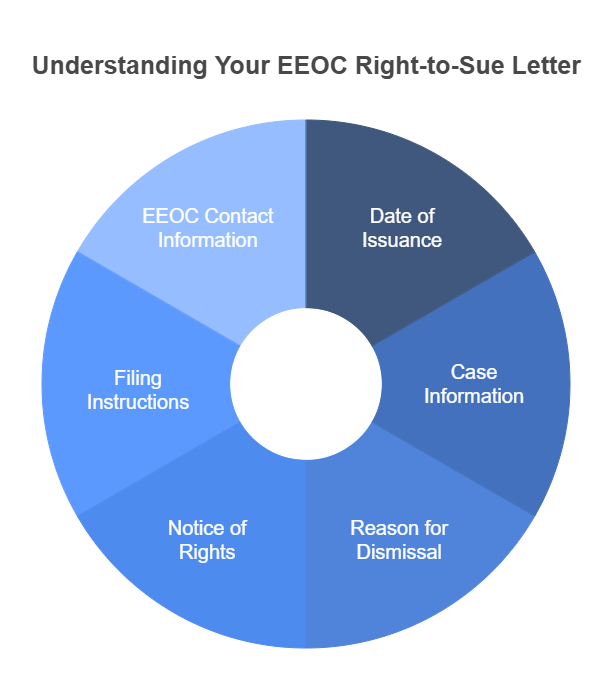EEOC Right-to-Sue Letter in California: Your Complete Guide

If you’ve experienced workplace discrimination in California, you’ve likely encountered the term “Right-to-Sue letter.” This critical document represents a pivotal moment in your employment discrimination case.
Receiving this letter can feel overwhelming. The clock starts ticking immediately, and missing critical deadlines could permanently forfeit your right to seek justice.
Our discrimination lawyers in California provide comprehensive support through every step of your employment discrimination case, fighting to protect your rights when you need it most.
What is a Right-to-Sue letter?
A Right-to-Sue letter is an official document issued by either the Equal Employment Opportunity Commission (EEOC) or California’s Civil Rights Department (CRD, formerly DFEH) that grants you permission to file a lawsuit against your employer for discrimination or harassment.
This letter serves as confirmation that you’ve completed the required administrative process before taking legal action.
📌 This letter is often the final step in the EEOC or CRD process before a civil lawsuit.
The issuance of this document doesn’t indicate whether your case has merit. It simply means you’ve fulfilled the administrative prerequisites to pursue your claim in court.

Does the EEOC always issue a Right-to-Sue letter?
The EEOC will issue a Right-to-Sue letter in several situations. These circumstances include when the agency completes its investigation without finding sufficient evidence of discrimination. Another scenario occurs when mediation attempts fail to resolve your complaint.
Even if the EEOC closes your file without a full investigation, it still issues a notice of rights (which serves as your Right-to-Sue letter) marked as a “Dismissal.” You can request a Right-to-Sue letter after 180 days have passed since filing your initial charge, even if the EEOC hasn’t completed its investigation.
The agency may also issue the letter when it finds reasonable cause to believe discrimination occurred but chooses not to litigate the case itself.
Is a Right-to-Sue letter good or bad?
Receiving a Right-to-Sue letter is neither inherently good nor bad for your case. It simply means the EEOC or CRD has completed its process or that you’ve requested to move forward with a lawsuit.
Many valid claims proceed with a Right-to-Sue letter even when the EEOC declines to pursue the case directly.
Potential positives:
- Freedom to proceed: You can now file a lawsuit in federal court or state court, depending on which agency issued the letter.
- Control over your case: Our employment attorney will determine the best strategy going forward.
Potential challenges:
- Limited time: You face strict deadlines to file your lawsuit after receiving the letter.
- Need for legal representation: The complexity of employment discrimination cases typically requires our experienced attorney.
⚠️ Once the EEOC issues your Right-to-Sue letter, you have just 90 days to file a lawsuit in federal court, or you lose your right to sue under federal law.
Don’t wait until the last minute. Missing the 90-day window means permanently losing your right to sue under federal employment laws, regardless of how strong your case might be.
Can I sue without a Right-to-Sue letter from the EEOC?
In most federal employment discrimination cases under laws like Title VII, the Americans with Disabilities Act (ADA), or the Age Discrimination in Employment Act (ADEA), you must obtain a Right-to-Sue letter before filing a lawsuit.
California state law offers some different procedures through the CRD for cases under the Fair Employment and Housing Act (FEHA).
Here’s how the requirements compare:
| Jurisdiction | Letter Required? | Timeline to Sue | Types of Claims |
|---|---|---|---|
| EEOC (Federal) | Yes | 90 days after the letter is issued | Title VII, ADA, ADEA, Equal Pay Act violations |
| CRD (State) | Yes | 1 year after the letter was issued | FEHA violations, including discrimination based on sexual orientation |
For certain claims, like those under the Equal Pay Act, you may go to court without first filing with the EEOC, though there are advantages to filing with the agency first.
Some harassment claims also have exceptions to the administrative filing requirement, particularly in cases involving a hostile work environment or quid pro quo harassment.
Additional reading: how to sue a company for discrimination
Our Huntington Beach workplace discrimination lawyer will evaluate your case and determine the best path forward, whether through federal or state proceedings.
How long does it take to get a Right-to-Sue letter from the EEOC?
If you request your Right-to-Sue letter early (after the minimum 180-day waiting period), you can typically expect to receive it within 30 days of your request.
If you wait for the EEOC to complete its full investigation, the timeline varies significantly. While waiting, document everything related to your case and maintain a detailed timeline of events. This documentation will be invaluable if you need to file a lawsuit later.
⚠️ Remember that you cannot file a federal lawsuit for discrimination until you receive this letter, making it a critical part of the process.
The state’s CRD process follows a similar timeline, though the agency aims to complete investigations within 365 days. Complex cases involving multiple allegations or respondents may take longer for either agency to process.

EEOC Right to Sue letter sample: What does it include?
An EEOC Right-to-Sue letter, officially called a “Dismissal and Notice of Rights,” contains several key elements that you should understand.
The document provides critical information about your rights and the next steps in your case.
A typical EEOC Right-to-Sue letter includes:
- Date of issuance: This establishes when your 90-day filing period begins
- Case information: Your charge number and details about your complaint
- Reason for dismissal: Why the EEOC is not pursuing your case further
- Notice of rights: Your right to file a lawsuit within 90 days
- Filing instructions: Basic guidance on how to proceed with a lawsuit
- EEOC contact information: Who to contact with questions
The letter will explicitly state the 90-day deadline for filing a lawsuit, which begins on the day you receive the letter, not the date printed on it.
💡 If your letter is marked “Dismissal and Notice of Rights,” don’t be discouraged. This standard title doesn’t mean your case lacks merit—it simply indicates the EEOC has completed its process and is transferring the right to pursue the matter to you.
Here’s a sample of what the letter could look like:
U.S. EQUAL EMPLOYMENT OPPORTUNITY COMMISSION
DISMISSAL AND NOTICE OF RIGHTS
To: [REDACTED NAME] From: Los Angeles District Office
[REDACTED ADDRESS] 255 E. Temple St., 4th Floor
Los Angeles, CA 90XXX Los Angeles, CA 90012
□ On behalf of person(s) aggrieved whose identity is CONFIDENTIAL (29 CFR §1601.7(a))
EEOC Charge No. EEOC Representative Telephone No.
546-20XX-XXXXX [REDACTED NAME], Investigator (213) XXX-XXXX
THE EEOC IS CLOSING ITS FILE ON THIS CHARGE FOR THE FOLLOWING REASON:
□ The facts alleged in the charge fail to state a claim under any of the statutes enforced by the EEOC.
□ Your allegations did not involve a disability as defined by the Americans With Disabilities Act.
□ The Respondent employs fewer than the required number of employees or is not otherwise covered by the statutes.
■ The EEOC has adopted the findings of the state or local fair employment practices agency that investigated this charge.
□ Other (briefly state): _________________________________________________________________
– NOTICE OF SUIT RIGHTS –
(See the additional information attached to this form.)
Title VII, the Americans with Disabilities Act, the Genetic Information Nondiscrimination Act, or the Age
Discrimination in Employment Act: This will be the only notice of dismissal and of your right to sue that we will
send you. You may file a lawsuit against the respondent(s) under federal law based on this charge in federal or state
court. Your lawsuit must be filed WITHIN 90 DAYS of your receipt of this notice; or your right to sue based on
this charge will be lost. (The time limit for filing suit based on a claim under state law may be different.)
Equal Pay Act (EPA): EPA suits must be filed in federal or state court within 2 years (3 years for willful violations) of the
alleged EPA underpayment. This means that backpay due for any violations that occurred more than 2 years (3 years)
before you file suit may not be collectible.
On behalf of the Commission
_________________________ _______________
[REDACTED NAME] (Date Mailed)
District Director
cc:
[REDACTED EMPLOYER NAME]
c/o [REDACTED ATTORNEY NAME]
[REDACTED LAW FIRM]
[REDACTED ADDRESS]
Los Angeles, CA 90XXX
A hypothetical scenario surrounding an EEOC notice of right to sue
Here’s how the Right-to-Sue process might unfold in a typical case:
Maria, an administrative assistant at a Los Angeles technology firm, experienced ongoing sexual harassment from her supervisor. Despite reporting the issue to HR multiple times, no action was taken to remedy the situation.
After months of enduring a hostile work environment, Maria filed a charge with the EEOC, providing detailed documentation of the harassment and the company’s failure to address her complaints.
The EEOC conducted an investigation, interviewing witnesses and reviewing company policies. After six months, the investigator determined there was reasonable cause to believe discrimination occurred but chose not to litigate.
Upon receiving her Right-to-Sue letter, Maria immediately consulted with an employment discrimination attorney who reviewed her case and explained the 90-day deadline to file in federal court. The attorney helped Maria understand that while the EEOC didn’t pursue her case, she still had a strong claim under both federal and state laws that prohibit sexual harassment.
With proper legal representation, Maria filed a timely lawsuit that eventually led to a settlement addressing both the violation of her rights and the company’s failure to enforce their anti-harassment policies.
Our Torrance workplace discrimination lawyer provides personalized guidance through the complex process of pursuing justice after workplace discrimination or harassment.
Reach out for expert legal help after receiving a Right-to-Sue letter
If you’ve received a Right-to-Sue letter from the EEOC or CRD, consulting with our experienced employment attorney should be your immediate next step. Our employment law firm will evaluate the strength of your case and help you understand what compensation you might be entitled to receive.
📌 Remember that the 90-day deadline (for federal cases) or one-year deadline (for California state cases) begins as soon as you receive your letter, so timely action is essential.
Our firm will assist you with every aspect of your case, from gathering evidence to filing your lawsuit in the appropriate court. We will also represent you in any further mediation attempts that might resolve your complaint without going to court.
Don’t wait—contact us at (310) 340-1112 or reach out online for a free consultation. Our experienced employment attorneys will help you meet critical deadlines and take the next legal step with confidence.
FAQs
What if I lost my Right-to-Sue letter or never received it?
If you’ve lost your Right-to-Sue letter or believe it was never delivered, contact the EEOC or CRD immediately. The agency can issue a replacement letter, though you’ll need to provide your charge number or other identifying information.
Can I get an extension if I miss the 90-day deadline?
Extensions to the 90-day filing deadline are rarely granted and only in exceptional circumstances, such as if you were physically incapacitated. Courts typically enforce this deadline strictly, which is why immediate legal consultation is essential upon receiving your letter.
What should I do if my employer retaliates after I file with the EEOC?
Retaliation for filing a discrimination complaint is illegal under both federal law and California state laws. If your employer takes adverse action against you after you file, document everything and report the retaliation to the EEOC or CRD immediately.
Do I need a lawyer to file a lawsuit after getting the Right-to-Sue letter?
While not legally required, having our attorney significantly improves your chances of success. Employment discrimination cases involve complex legal standards that our experienced discrimination attorney understands how to manage effectively.
What happens if the EEOC finds cause but still gives me a Right-to-Sue letter?
If the EEOC finds reasonable cause to believe discrimination occurred but still issues a Right-to-Sue letter, this can actually strengthen your position in court. The EEOC may choose not to litigate due to resource constraints rather than doubts about your case’s merit.
Related Posts


Facial Scarring Compensation Calculator in California

How Are Slip and Fall Settlements Calculated in California

Fatal Hit-and-Run in Santa Clarita Crash

19-Year-Old Severely Injured in Panorama City Crash




